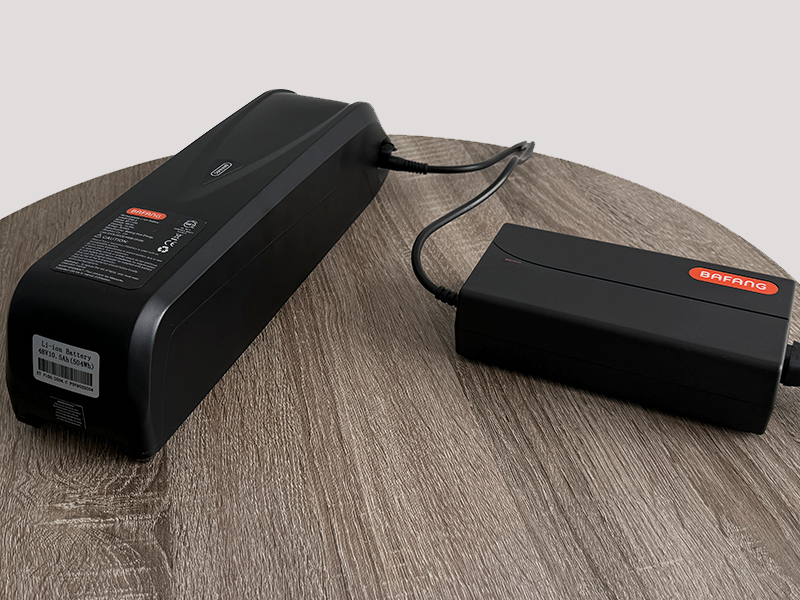Sun E350 Quick Start GuideUpdated 5 months ago

Introduction
Congratulations on your purchase of the Sun E350 B1 Electric Trike! The second-generation Sun E350 B1 Electric Trike brings enhanced comfort, control, and power to every ride. Upgraded with a 48V system, color display, and expandable battery mount, it’s designed for longer, more leisurely rides. The low-step frame, upright handlebars, and wide saddle provide a relaxed, natural riding position, while pedal-assist and throttle modes make every trip effortless. Tested to UL 2849 and UL 2271 standards, the E350 is a reliable, rider-focused solution for everyday electric mobility.
Get ready to ride in comfort, with confidence—your new Sun E350 B1 Electric Trike is ready to roll!
NOTICE: This guide provides a basic overview and is not a substitute for the official manuals included with the Sun E350 B1 E-Trike. Please be sure to read and fully understand the information provided in the following manuals before use.
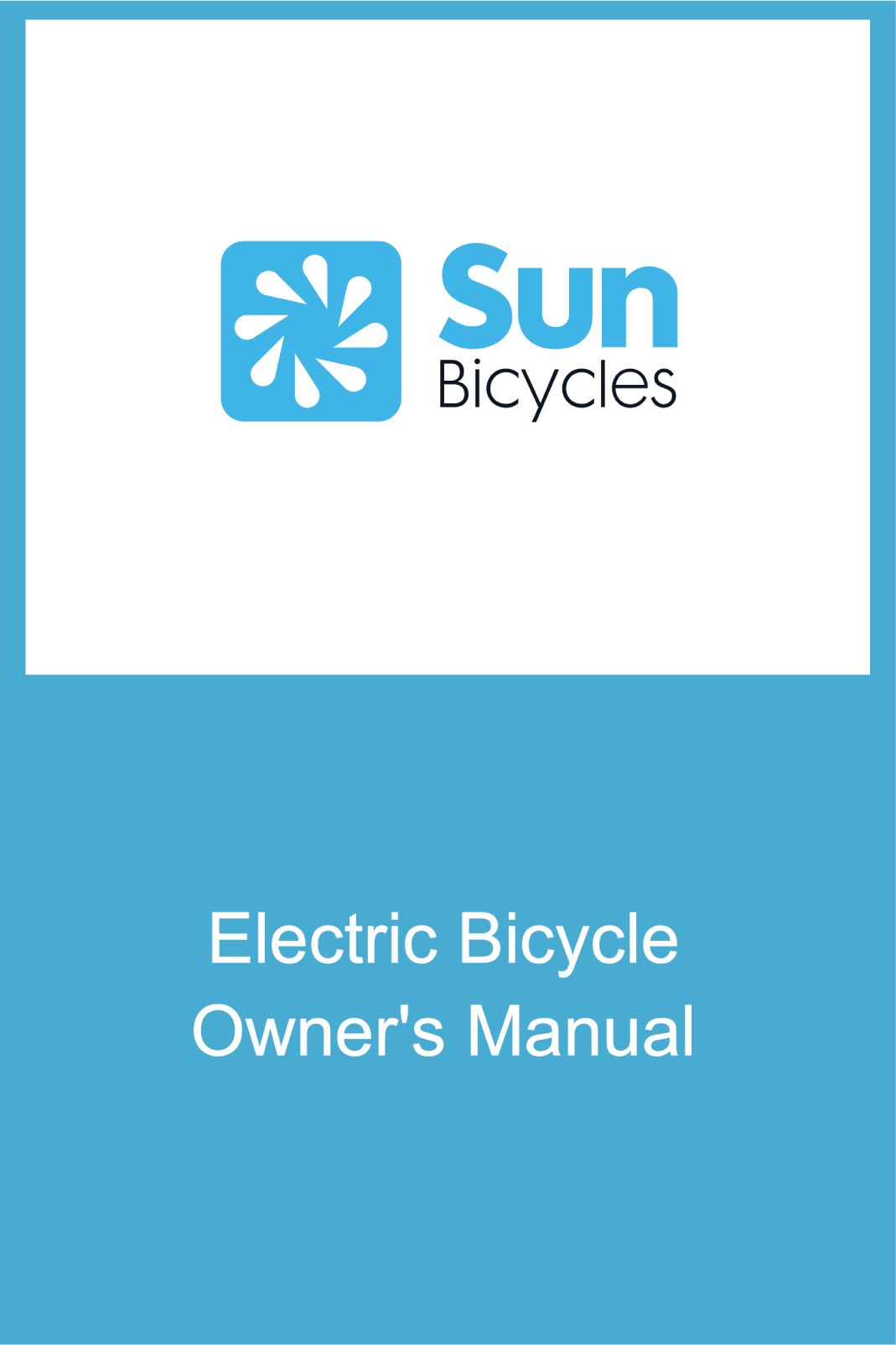 |  | 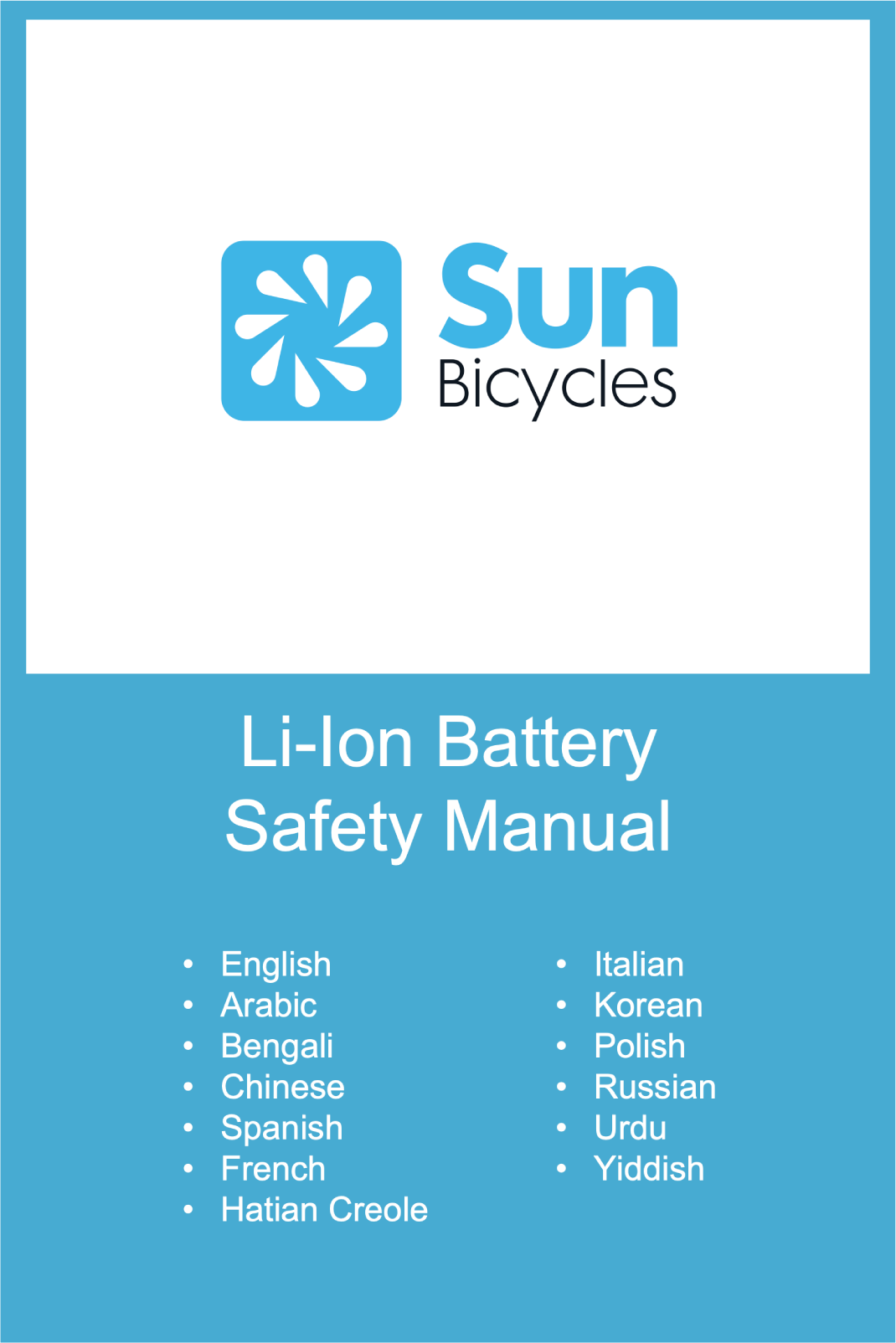 |
Before Your First Ride
To ensure you have the best experience, follow these steps before your first ride:
1. Assembly: When purchased new from your local Sun Bicycles retailer, the E350 B1 E-Trike comes fully assembled and ready to ride.
2. Charge Your Battery: Use the supplied charger to fully charge the battery before your first ride. A full charge typically takes around 5 to 6 hours.
3. Safety Check: Before your first ride and regularly before each subsequent ride, conduct the safety checks detailed below and any other safety verifications detailed in the Owner's Manual to guarantee the trike's safety for riding. Ignoring this warning could lead to severe personal injury.
Ensure all fasteners, including nuts, bolts, and screws, are appropriately tightened for the seatpost, stem, and handlebar. Check their tightness by securing the bike between your legs and attempting to twist, push, and pull the handlebar and saddle. If any component moves, realign it, increase bolt tension, and repeat until there is no movement.
Inspect tires and wheels to ensure they spin freely without any wobbling. Wheels should be centered within the frame and fork. If there’s any wobbling or misalignment, and you are uncertain about the cause, seek assistance from a Sun Bicycles Retailer or other reputable bike shop.
4. Adjust Your Saddle: Set the saddle height for comfortable pedaling. With the pedal at its lowest position, your leg should have a slight bend at the knee. Check the tilt to maintain a level or slightly angled position for optimal comfort and support.
5. Check Your Handlebar Position: Ensure the handlebars are properly aligned and adjusted to a comfortable height and angle for optimal control and comfort.
6. Check Tire Pressure: Proper tire pressure ensures a smooth and safe ride. Refer to the tire sidewall for the recommended PSI (pounds per square inch) and inflate as necessary.
7. Wear a Helmet: Always wear a certified helmet to protect yourself, and review local laws for any additional required safety equipment.
8. Use lights at night: For your safety, always use lights at night and review local laws for specific lighting requirements.
Powering On Your E-Trike
To turn on your E350 B1 e-trike, Press the (⏻) Power button on the handlebar-mounted display for at least 2 seconds until the display lights up. The display defaults to the main screen, which displays the Battery Level, Current Speed, Power Assist Mode, Trip Distance, and Estimated Range.
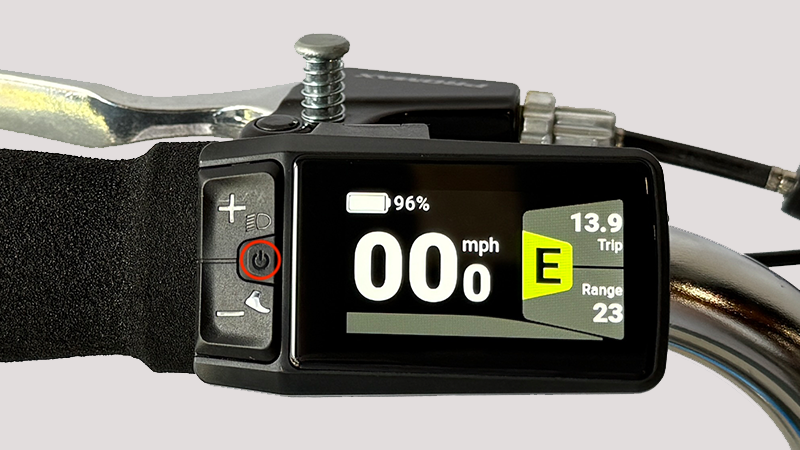
Note: When your e-bike is powered on, the throttle remains disabled until you switch the Power Assist System (PAS) mode from Off, Eco, Tour, Sport, Sport +, or Boost mode.
Using the Display
The display on your E350 B1 E-Trike serves as a central hub of information and control, enhancing your riding experience by providing key data and allowing you to adjust various settings.
Adjust the Power Assist System (PAS) Levels: Choose from O (no assist) to Boost mode for maximum assistance. Use the (+) Plus and (-) Minus buttons to adjust between modes.
- (O) Off
- (E) Eco Mode
- (T) Touring Mode
- (S) Sport Mode
- (S+) Sport Plus Mode
- (B) Boost Mode
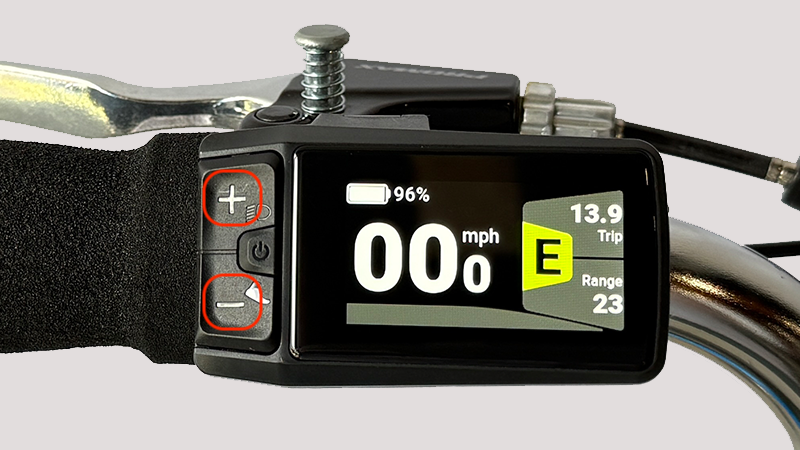
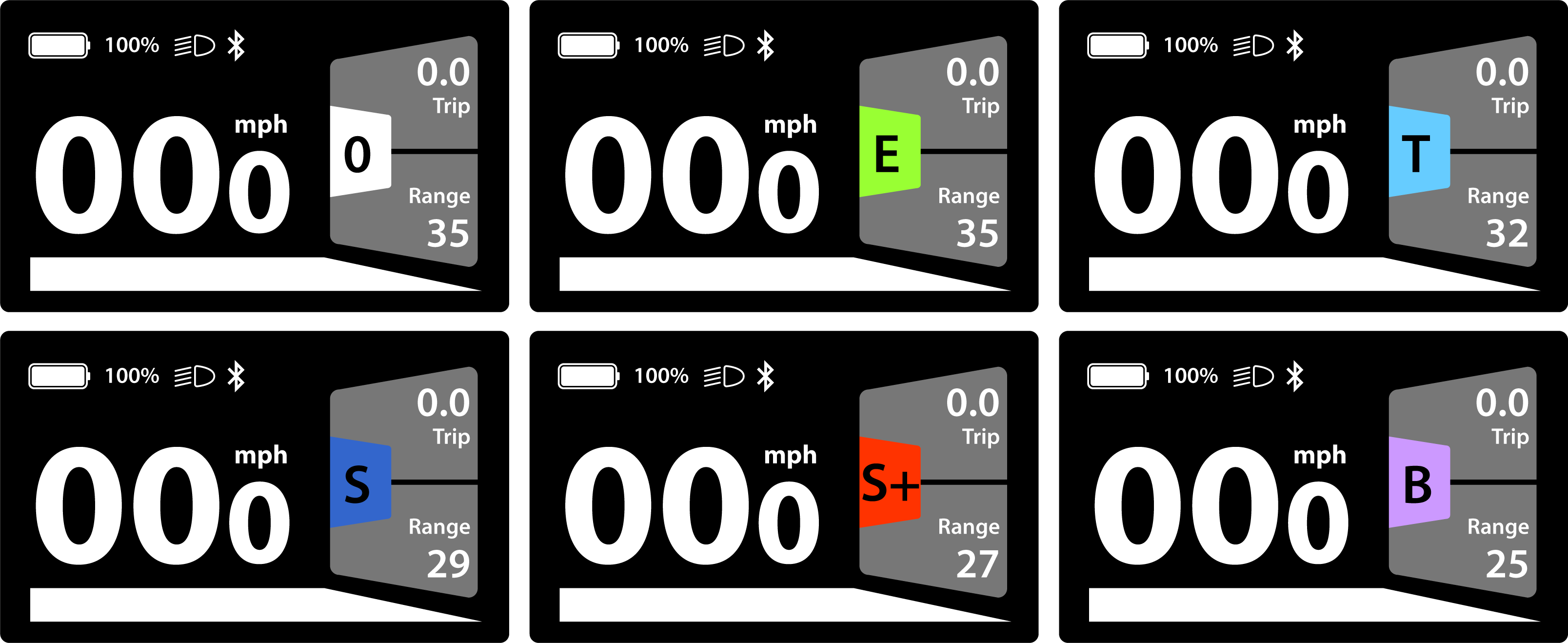
Note: The Power Assist System (PAS) responds directly to your pedaling effort. The bike’s cadence sensor, located in the bottom bracket, detects pedaling motion and applies motor assistance for a smooth and efficient ride.
Using Walk Assist Mode: Set the pedal assist level to “Walk Mode” using the (-) Minus Button, then press and hold the (-) Minus button to engage Walk Assist. The bike will move at walking speed as long as you continue pressing the (-) Minus button.

Navigating the Display Screens: Cycle through the (4) four different screens by briefly pressing the (⏻) Power button.
1. Main Display: Battery Level, Current Speed, Current Power Assist Level /Mode (O, Eco, Touring, Sport, Sport +, Boost), Trip Distance, and Estimated Range

2. Screen 2: Battery Level, Current PAS Mode, Current Speed, Trip Distance, and Odometer

3. Screen 3: Battery Level, Current PAS Mode, Max Speed, Average Speed, & Pedal Cadence.

4. Screen 4: Battery Level, Calories Burned, Ride Time, & Power Output (Watts)
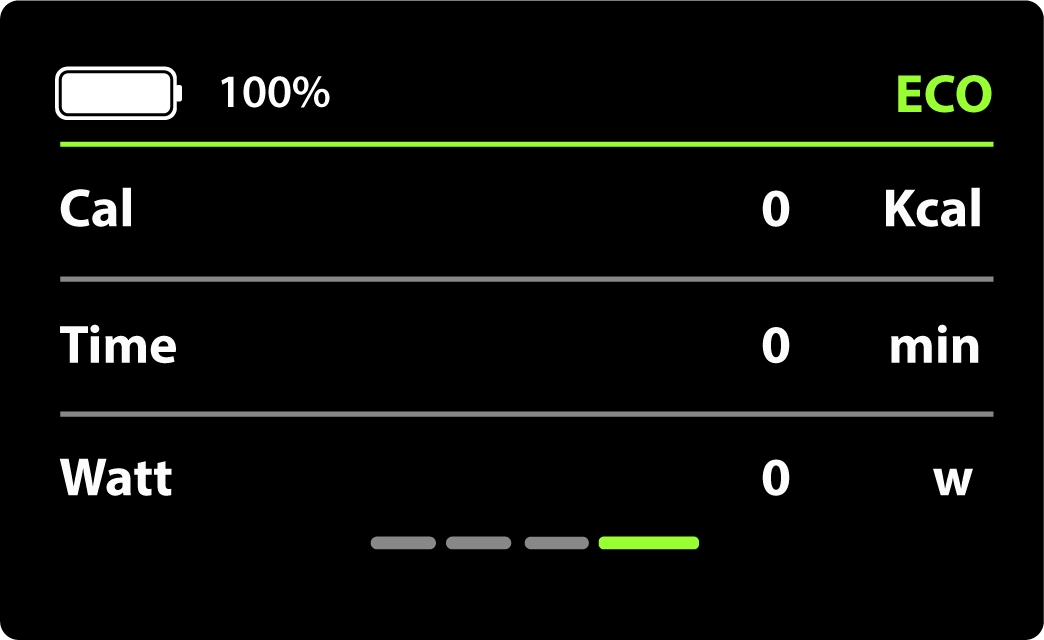
Using the Throttle
The E350 B1 E-Trike has a throttle, allowing you to accelerate without pedaling. Gently press the throttle to increase speed, but be cautious in high-traffic or pedestrian areas.

NOTE: Using the throttle bypasses the current PAS mode, allowing the trike to accelerate up to 10 mph. Relying solely on the throttle reduces the e-trike’s range by draining the battery faster. For optimal range and battery life, use the throttle sparingly and combine it with pedaling.
Starting Your Ride
Adjust the Power-Assist Levels: Use the (+) Plus and (-) Minus buttons to adjust between PAS Modes. Choose from (O) Off for no power assist to (B) Boost mode for maximum assistance.
The Power Assist System (PAS) responds to your pedaling. The trike’s cadence sensor in the bottom bracket detects pedal motion to trigger smooth, consistent motor assistance.
If you're new to electric trikes, start in (E) Eco Mode and spend some time getting used to the Power-Assist System.
- Take it Slow at First: Practice in a safe area before venturing out onto busy roads or paths.
- Stay Visible: Wear bright clothing and use your lights when riding at night or in low-light conditions.
- Check Local Regulations: Laws regarding e-bike usage vary, so ensure you’re familiar with the rules in your area.
Understanding the 6 Power Assist System (PAS) Modes
Power Assist System (PAS) modes on an electric trike are designed to control how much assistance the motor provides while you’re pedaling. Each PAS mode offers varying levels of support to suit different terrains, riding styles, and energy needs. Here’s a breakdown of the purpose of each typical PAS mode:
1. O (Off) Mode:

Purpose: In this mode, the motor is completely disengaged, and you ride the e-trike like a traditional trike. It’s useful when you want a full workout or to conserve the battery for later use.
Best For: When the rider wants no motor assistance or to conserve battery power entirely.
2. E (Eco) Mode:
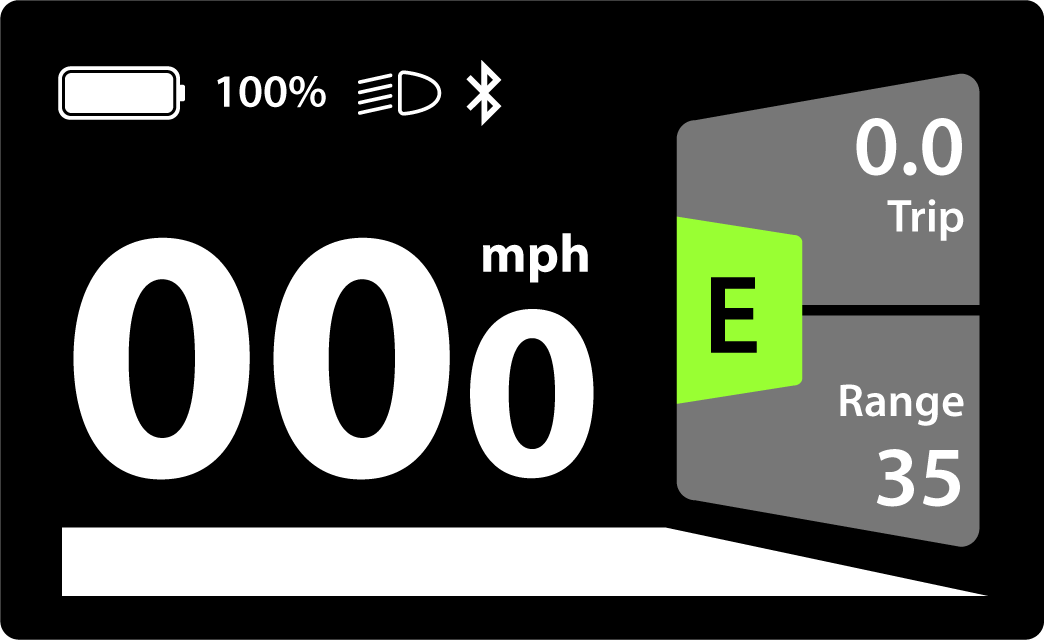
Purpose: This mode provides minimal motor assistance, allowing you to rely more on your pedaling effort. It is ideal for flat terrain, leisurely rides, or conserving battery life over long distances.
Best For: Riders who want to extend their range and use the e-bike primarily for light exercise or casual rides.
3. T (Tour) Mode:

Purpose: This mode offers moderate assistance, balancing pedal power, and motor assistance. It is perfect for riding in slightly hilly areas or for a consistent level of support without using too much battery.
Best For: Daily commuting, recreational rides, and mixed terrain where you need moderate help but still want to maintain a reasonable battery life.
4. S (Sport) Mode:
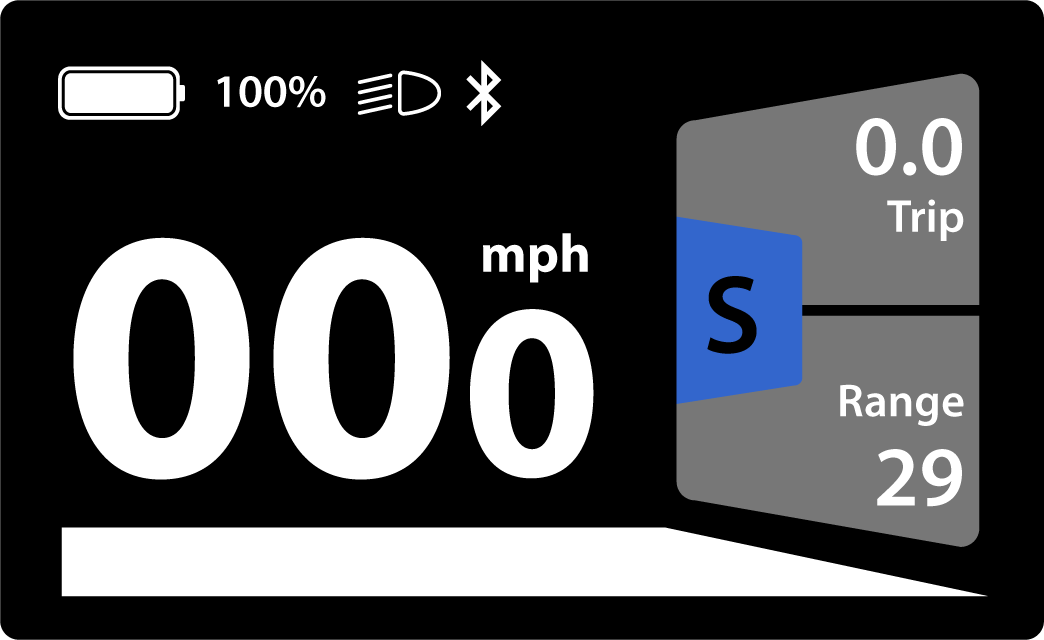
Purpose: This mode provides higher levels of assistance, making it easier to climb hills or maintain higher speeds with less effort. This mode helps cover ground faster or tackle more challenging terrain.
Best For: Hilly routes, quicker commutes, or when you want more assistance for a relaxed ride at higher speeds.
5. S+ (Sport+) Mode:

Purpose: This mode provides higher levels of assistance, making it easier to climb hills or maintain higher speeds with less effort. This mode helps cover ground faster or tackle more challenging terrain.
Best For: Hilly routes, quicker commutes, or when you want more assistance for a relaxed ride at higher speeds.
6. (B) Boost Mode:

Purpose: Delivers maximum motor assistance with minimal pedaling effort required. It’s ideal for steep inclines, difficult terrain, or when you’re in a hurry and want to get to your destination quickly.
Best For: Very steep hills, strong headwinds, or when you need the most power output from your e-bike for tough conditions.
Braking

The E350 B1 E-Trike is equipped with a linear pull brake on the front and a disc brake on the rear, which offer significantly more stopping power than traditional brakes. It’s recommended to practice using them in a safe area, as their stronger braking force requires getting used to before venturing onto busy roads or paths.
Range
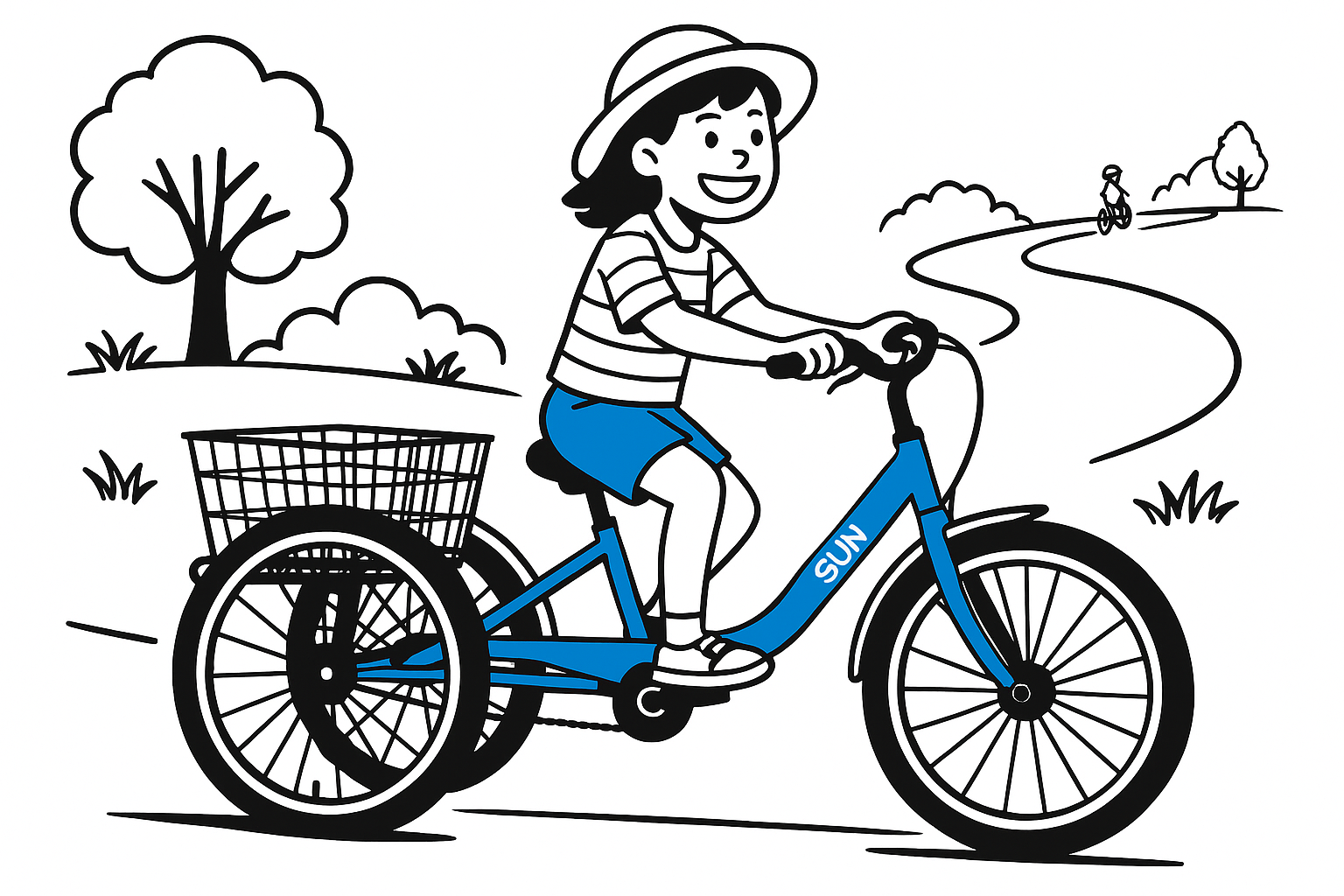
The estimated range of the E350 B1 E-Trike can vary depending on several factors, including rider weight, terrain, riding style, and assist level. Based on the battery capacity, the approximate range is as follows.
- Under optimal conditions (low assist, flat terrain): Up to 35 miles
- Under more demanding conditions (high assist, hills): Around 25 miles
Note: Your actual range will vary based on riding conditions and how you use motor assist.
Important: Battery performance will naturally decline over time as the battery ages.
Limitations & Warnings
- RIDER WEIGHT LIMIT – The maximum rider weight limit for this trike is 250 lb
- CARGO WEIGHT LIMIT – The maximum recommended cargo limit is 50 lb
- ⚠️ WARNING! – Never place a child, pet, or any passenger in the basket
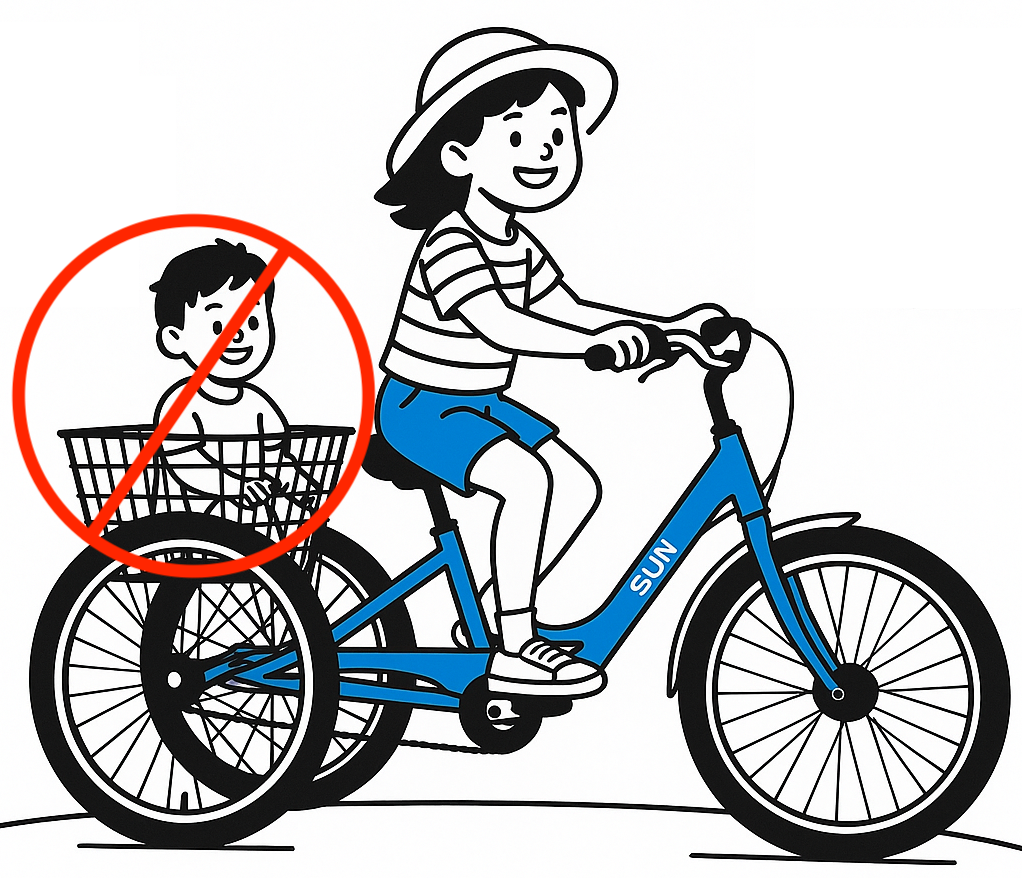
Battery – Removal
1. Insert the key and turn it counterclockwise while gently pushing the battery from the rear.

2. Continue sliding the battery backward until it fully disengages from the trike.

Battery – Charging
1. Use the Correct Charger: Always use the charger that comes with your e-trike. Using an incorrect charger will void the warranty and can damage the battery or pose safety risks.
2. Charge Time: Your e-trike has a 48V x 10.5Ah battery, and the supplied charger operates at two amps per hour. The estimated charge time is 5 to 6 hours.
3. Charge at Room Temperature: Charge the battery in a dry, cool place in close proximity to a working smoke detector, avoiding extreme temperatures. Charging at temperatures outside the range of 40 to 70°F can harm battery performance and longevity.
4. Monitor Charging: Do not charge the battery unattended or overnight.
5. Don't Overcharge: Most modern e-trike batteries and chargers are designed to prevent overcharging, but it's still a good idea to unplug the charger once it's fully charged to avoid potential issues.
6. Partial Charges Are Okay: Lithium-ion batteries, standard in e-trikes, do not suffer from the memory effect seen in older battery types. You can charge them even when they're not fully discharged without affecting their lifespan.
7. Avoid Depleting the Battery Completely: Try to recharge your battery before it's completely empty. It is preferable to keep the charge level between 20 and 80%. Deep discharges can stress the battery and reduce its lifespan.
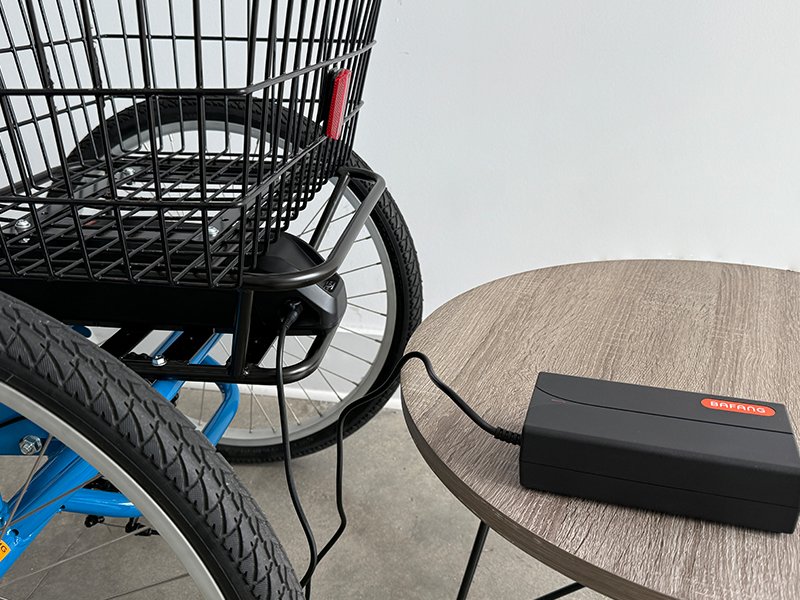

Battery – Sleep Mode
Sleep mode is a power-saving feature designed to conserve battery life when it is not in use for an extended period. When the battery enters sleep mode, it shuts down most of its functions to minimize energy consumption. This is particularly useful for preventing the battery from slowly discharging while the bike is stored or not in use for days or weeks.
- Press and hold the Power Button for 10 seconds.
- If the charge level is 40-100%, the battery will enter sleep mode if not used for 30 days.
- If the charge level is 10-39%, the battery will enter sleep mode if not used for 14 days.
- If the charge level is 1-9%, the battery will enter sleep mode if not used for 48 hours.
- If the charge level is below 1%, the battery will go into sleep mode within 10 minutes.
Important: To wake up your battery from sleep mode, connect it to the charger.
Battery – Storage
If you plan not to use your e-trike for an extended period, such as during the winter, it is best to remove the battery pack and store it according to the guidelines below.
1. Optimal Charge Level for Storage: If you won't be using your e-trike for an extended period, store the battery at a 30% to 60% charge level. This range is generally considered ideal for lithium-ion batteries.
2. Temperature Matters: Store the battery in a cool, dry place, away from direct sunlight or extreme temperatures. Ideal storage temperatures range from 40 to 70°F.
3. Recharge Periodically: If you plan to store the battery for an extended period, recharge it to the recommended storage level every 3 to 4 months to compensate for the natural discharge that occurs over time.
4. Avoid Humidity and Water Exposure: Keep the battery in a dry environment to prevent corrosion or damage to its components.
5. Physical Protection: Store the battery in a way that avoids physical damage, including punctures or impacts.
Battery – Transportation
When transporting your battery for an extended period, such as taking it on holiday, you should discharge it to approximately 30% and only fully charge it again at your final destination.
Ensure that you handle your battery with care and avoid any impacts or hard shocks during transportation.
Final Words
Now that you’re familiar with your new E350 B1 E-Trike, you’re ready to ride! Take advantage of this fun, efficient, and eco-friendly way to travel, and enjoy your journey. Happy riding!
